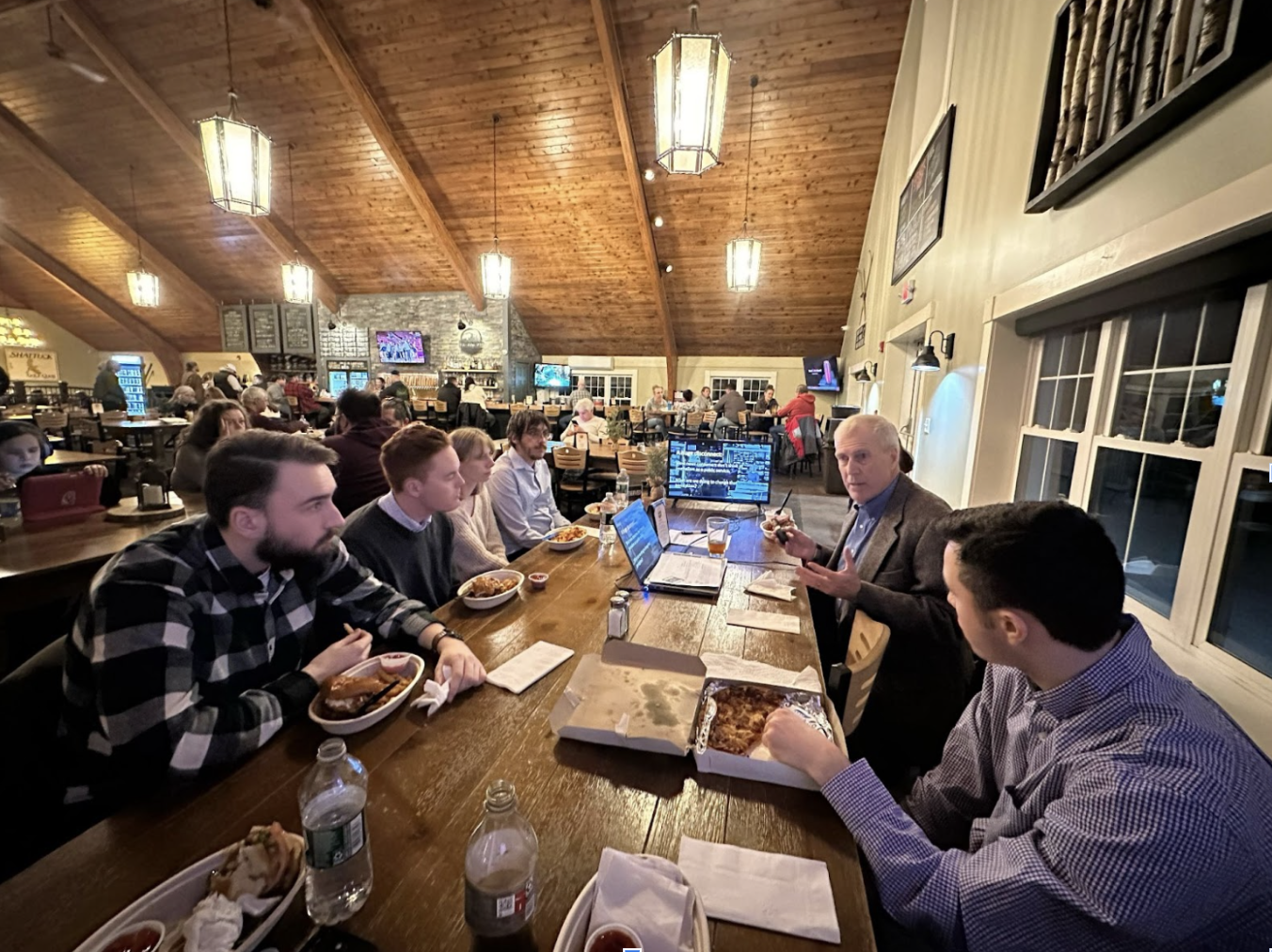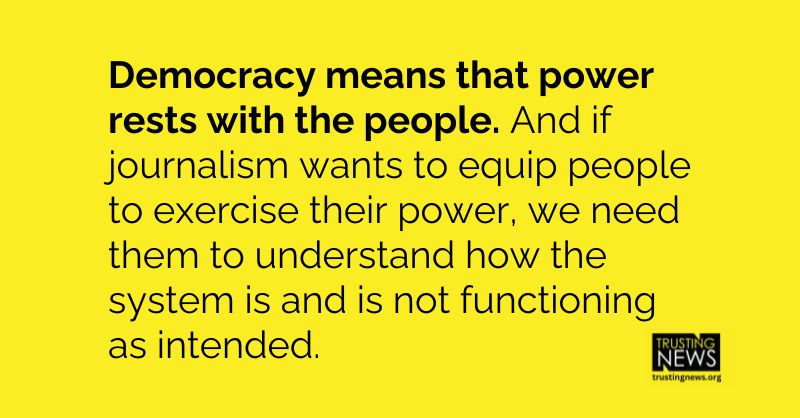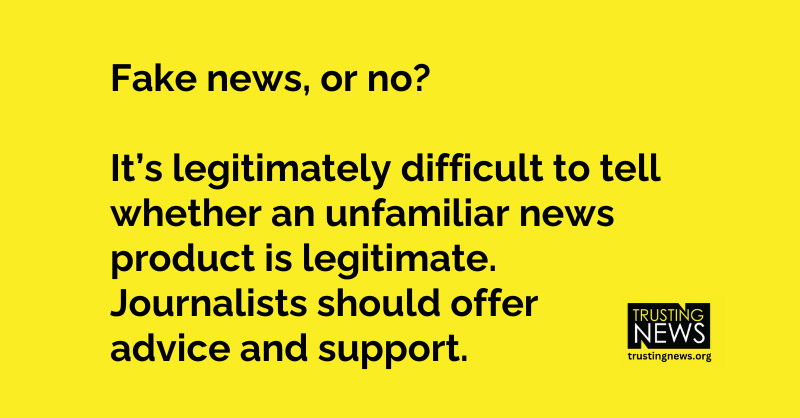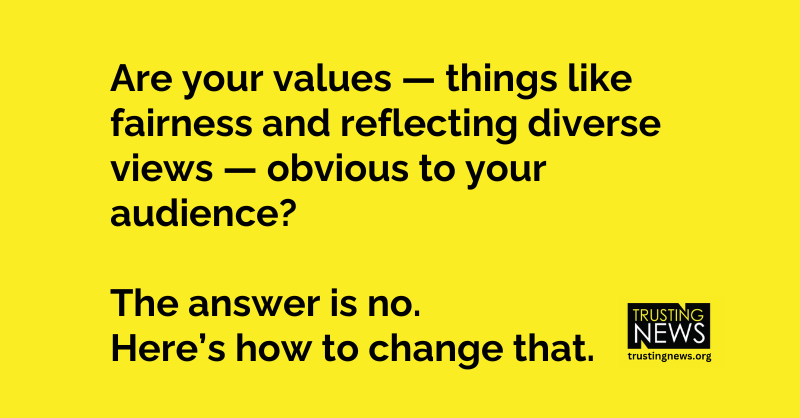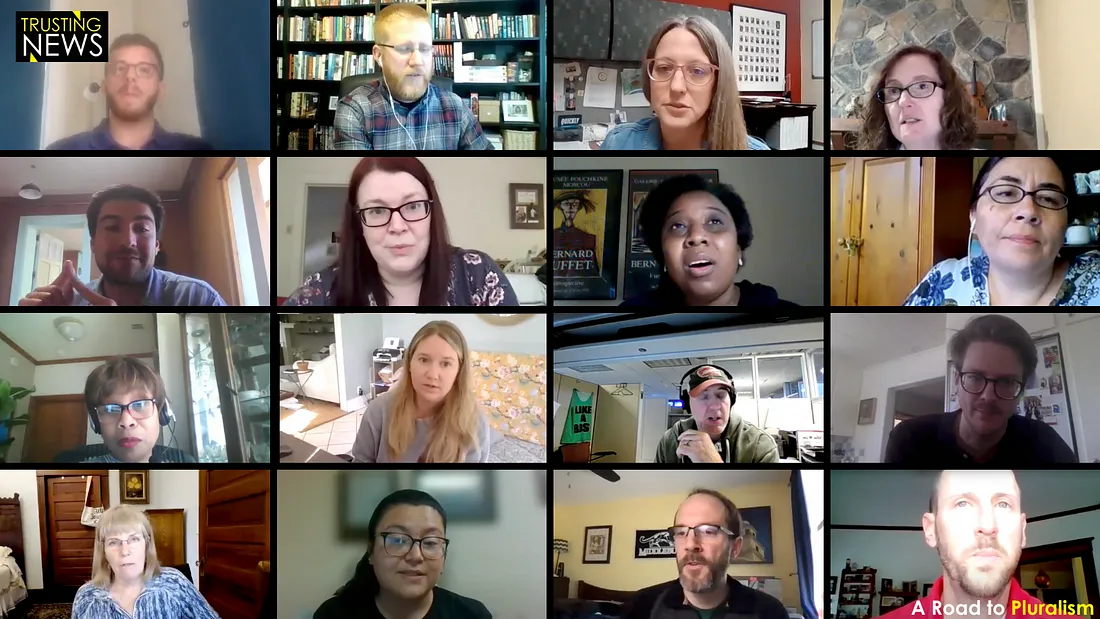
At Trusting News, rather than accepting distrust in journalism, we work to better understand it so we can help journalists actively earn trust. We believe healthy democracies depend on civic dialogue and a shared set of facts. We also believe local news can play an especially important role in bridging conversations across political divides. With […]
New research shows how journalists can connect with conservatives and right-leaning audiences
At Trusting News, rather than accepting distrust in journalism, we work to better understand it so we can help journalists actively earn trust. We believe healthy democracies depend on civic dialogue and a shared set of facts. We also believe local news can play an especially important role in bridging conversations across political divides.
With this in mind, we conducted research with the Center for Media Engagement to better understand the societal and psychological forces that influence polarization and perceptions of news.
Read the full research report: How journalists can connect with conservatives and right-leaning audiences
The research suggests journalists can help bridge the divide between the news media and conservative, right-leaning audiences by listening and building relationships with conservatives in their community, avoiding catch-all labels and over-generalizations, focusing on facts, correcting mistakes and paying attention to the political beliefs and backgrounds of newsroom staff.
For this research, we partnered with 27 newsrooms to hear directly from self-identified conservative and right-leaning news consumers of local news. More than 3,400 Americans responded to a questionnaire that was distributed by the local newsrooms. This resulted in 91 in-depth interviews with news consumers across the country.
Rewatch our event where we give a summary of the research results and hear from local journalists who conducted interviews.
We’re so grateful to the journalists who took the time to conduct this research with us. Their willingness to invest in learning about their audiences makes our collective insights possible. The journalists work around the country and represent a mix of newsroom sizes, platforms and audience perspectives. The map below shows the locations of each of the newsroom participants.
The Research
The interviews and surveys showed that people who identify as conservative said they often felt portrayed stereotypically in the news. They also said they believe journalists have a bias against conservatives and those with right-leaning viewpoints. (We want to acknowledge that “conservative” should not be used as a catch-all term to describe how a particular group thinks, feels or acts. When discussing and referencing this research we have decided to say “conservative or right-leaning” because all of the participants selected either “conservative” (74.9%) or “very conservative” (25.1%) to describe themselves.) See the graph below to learn more about how participants identify politically.
Our work at Trusting News is always solutions-focused and aimed at developing strategies that will improve the relationship journalists have with the people they aim to serve. Finding areas of improvement, in this case, wasn’t difficult. Previous research tells us that Democrats trust a variety of news sources while Republicans trust few — and they consider their anti-media attitudes to be a core part of their political identity. And while trust in local news is higher than trust in national news — even among conservatives — local journalists say they feel like they’re facing an uphill battle to demonstrate their credibility and ethics. Journalists also say they are sometimes in the dark about what elements of their coverage feel out of step with or irrelevant to people in their communities.
Based on the survey responses and in-depth interviews, the research team at CME has suggested six approaches journalists can take to better connect with their conservative and right-leaning audiences:
- Build relationships with people who have conservative and right-leaning viewpoints in your community and listen to them.
- Include a variety of voices from people with conservative and right-leaning views in stories. Journalists should be cautious of using “conservative” or other terms as catch-all labels for people who may have very different beliefs.
- Consider the diversity of political beliefs and backgrounds when hiring for the newsroom.
- Focus on story facts, not interpretation.
- Correct mistakes promptly to demonstrate trustworthiness.
- Don’t criticize only one side of an issue.
These recommendations are based on comments and complaints shared by the news consumers, which primarily fall into three categories: frustration and distrust of national news, the portrayal of conservatives in news coverage and the perception of bias in news content.
Local vs. national news
The new research from CME reinforces some elements from previous polls and research, especially when it comes to conservatives’ feelings about national news.
According to the research, “multiple participants raised concerns that local news seems to be overly reliant on national news, especially from wire services like The Associated Press.” The research also found “participants on average had low ratings for the believability of mainstream journalism, although they were significantly more likely to believe local mainstream journalism than national mainstream journalism.”
One news consumer, interviewed by The Alpena News in Michigan, said, “what you read from the AP is not balanced. …I don’t see any balance at all with AP. It’s just Trump bad, bad, bad. Biden good, good, good.”
Some of the journalists who conducted the interviews were surprised to hear the extent to which perceptions of their work were affected by perceptions of the national news they carry. But many were not.
Alison Gerber, editor of the Chattanooga Times Free Press, said the vast majority of the complaints she hears from conservatives are about wire copy, not the work of her staff. She and her staff have taken steps to edit AP stories — for example sometimes adding context or removing adjectives — to address what they know will cause portions of their audience to disregard the coverage as biased.
Portrayals of conservatives in news
Another theme throughout the interviews was how conservatives see themselves reflected in news stories.
According to the research, “multiple interview participants said they felt that media portrayals of conservatives seem to rely on narrow or extreme stereotypes, which they felt assume conservatives are racist, uneducated, unkind, or only care about money.”
One news consumer, interviewed by Chattanooga Times Free Press, said, “I can be pro-choice and want a gun. Right? And I can be pro capital punishment and support gay marriage and transgender rights. So we’re defined by these big talking points that … don’t necessarily define us on an individual basis.”
Some news consumers interviewed said this narrow view of conservatives made them afraid to express their views.
Mike Canan, senior director of local content at WCPO in Cincinnati, said the most common complaint he heard from the news consumers he interviewed was that journalists “paint conservatives all as Trumpers who are racists and bad people.”
He said, “all three people expressed extreme dismay about how conservatives were portrayed. Not just Trump, but how individuals, real people were portrayed. It made me think about things in a different way… How often are we painting people, in general, with too much of a broad brush?”
A closer look at how the people interviewed say they identify politically shows more identify as “conservative,” a “patriot,” “traditional,” “right-leaning” or “Republican” than as a “Trump supporter.” This reinforces the need for fewer generalizations and labels, not only for political groups but for racial groups, ethnicities, gender groups, etc.
For Canan, these conversations have led him to want to improve his news coverage.
“I want to make sure we do a better job of avoiding generalizations in all stories,” he said. “I have family in rural Ohio, and national media came in and said people in such, a such county believe this. But that is not what everyone believes. We (journalists) do this all the time. We say, ‘Hispanics believe x, the Black community feels y,’ but every time we go broad it’s a mistake. We need to do a better job with language. Unless you polled everyone in the county you cannot say that.”
Perceptions of bias in news
Many individuals interviewed also expressed concerns about bias in the news coverage they see, read and hear.
When asked about what they “wish journalists knew about how people with your political beliefs feel about the news,” 808 of those surveyed (25.3%) used the word bias in their response.
According to the research, “participants’ answers to this question showed that they perceive bias when journalists seem to be interpreting the news or its implications, in the selection of stories that are covered (or not covered), and in how journalists phrase questions.”
One survey participant contributed bias to the fact that major national media are located in big cities.
“I wish national media had a better grasp on the daily needs of our more rural southern and Midwest cities,” the person wrote. “I find a ‘disrespect’ from media who feel we are uneducated and ‘unwoke’ for not adopting a more liberal agenda.”
Emilie Stigliani, the executive editor at the Burlington Free Press, participated in the interviews. She told us that there isn’t anyone in her newsroom with a real rural background and that most employees come from families that are “at least second-generation white collar.”
Stigliani and other journalists conducting these interviews expressed increased awareness of and concerns about how the makeup of a newsroom can and does influence story selection and how stories are covered.
“A lot of our news coverage is driven by the lives that we live,” Stigliani said. This work “made me think that’s not necessarily everybody’s experience…We really have to rethink how we evaluate what’s news.”
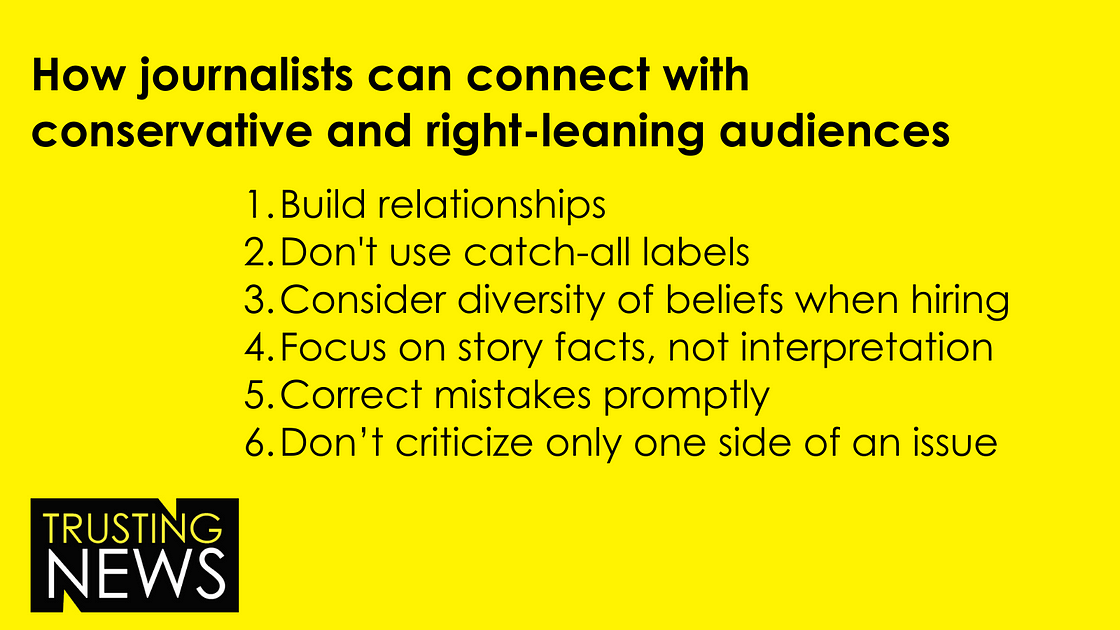
A Road to Pluralism
At Trusting News, our focus is on helping local newsrooms tell accurate, nuanced stories that are reflective of and relevant to people across the political spectrum. This research was the first step in a long-term new initiative for us:
A Road to Pluralism: Helping journalists strengthen trust across the political spectrum to bridge divides, foster productive conversations and fuel open-mindedness.
Our new Pluralism Network invites journalists into conversations and collaborations addressing how journalism can reach and be trusted by a more diverse audience with fact-based, responsible journalism. Our goal is to strengthen trust across the political spectrum by helping journalists bridge divides, foster productive conversations and fuel open-mindedness.
Read more about A Road to Pluralism and how you can get involved here.
At Trusting News, we learn how people decide what news to trust and turn that knowledge into actionable strategies for journalists. We train and empower journalists to take responsibility for demonstrating credibility and actively earning trust through transparency and engagement. Subscribe to our Trust Tips newsletter. Follow us on Twitter and LinkedIn. Read more about our work at TrustingNews.org.
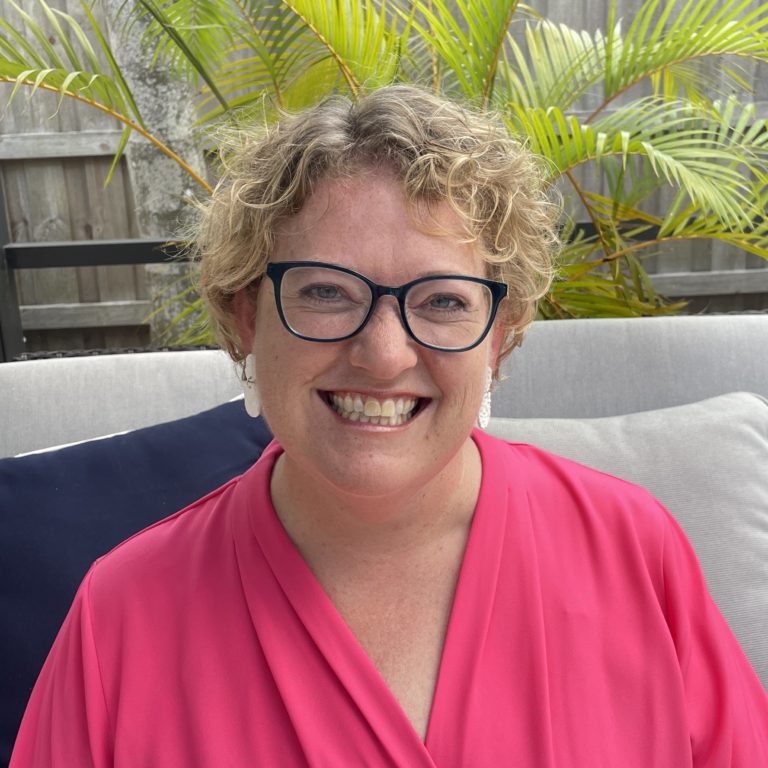
Executive Director Joy Mayer (she/her) founded Trusting News in 2016 after a 20-year career in newsrooms and teaching. She lives in Sarasota, Florida, and can be reached at joy@TrustingNews.org.
